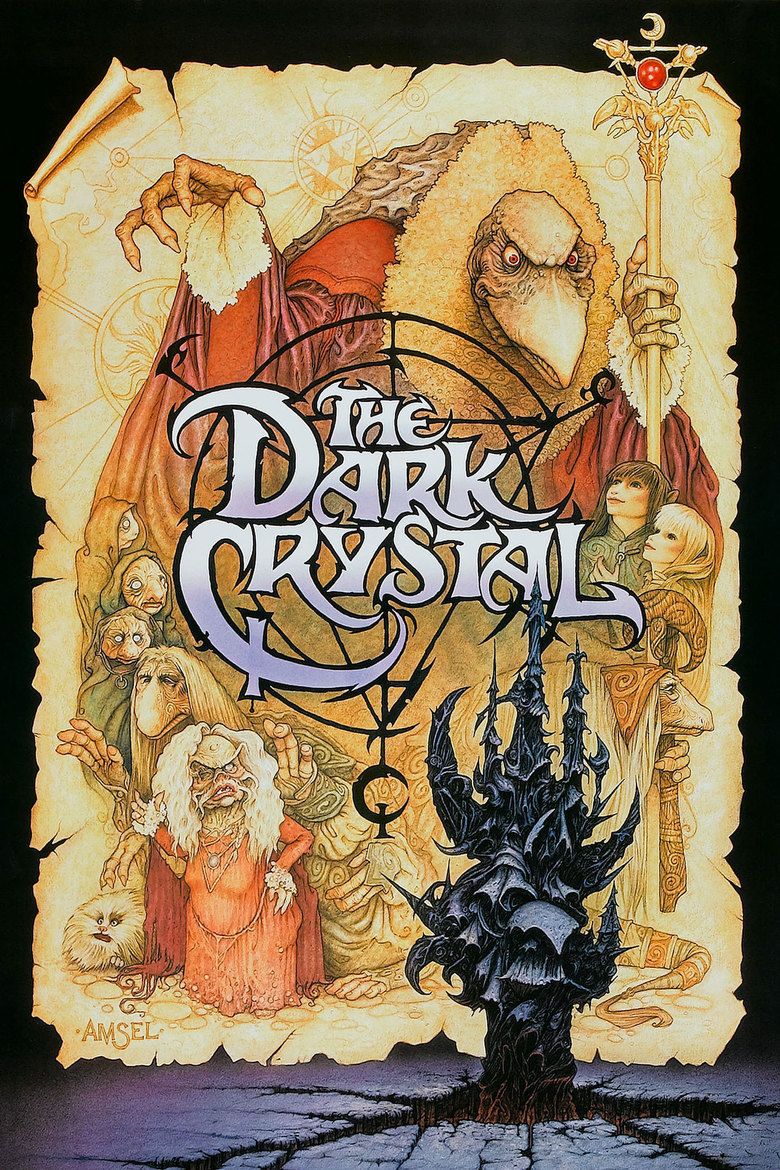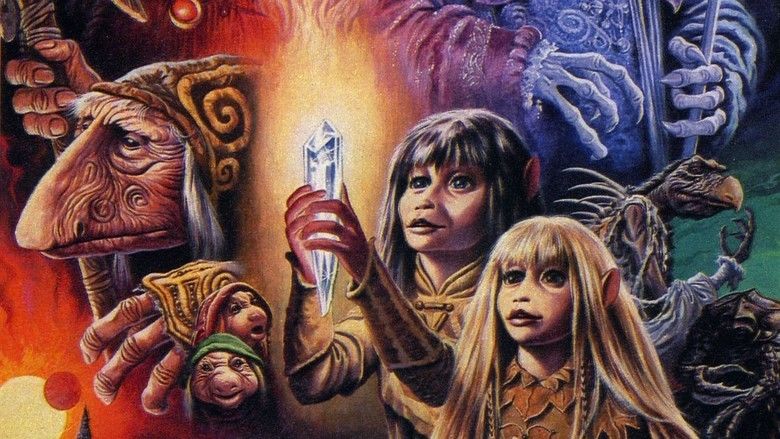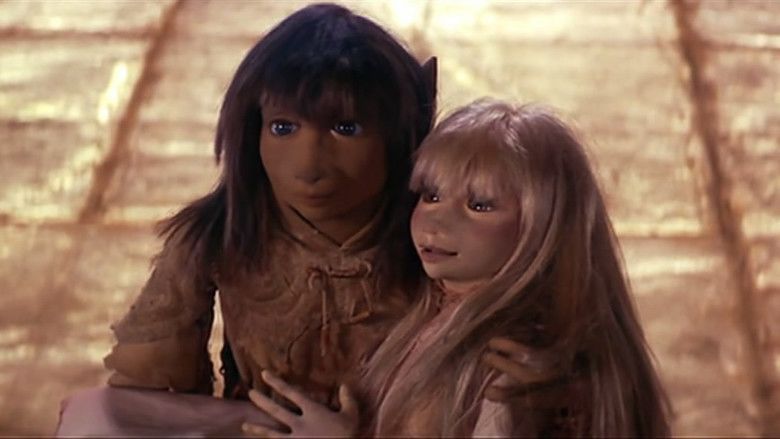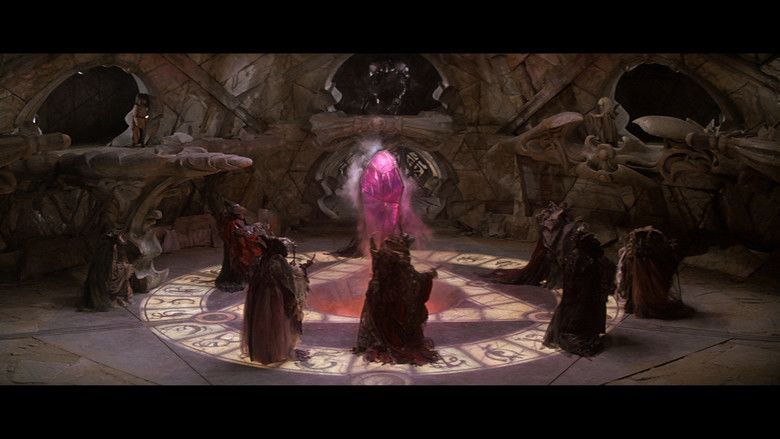The Dark Crystal
7.8 /10 1 Votes7.8
72% Rotten Tomatoes Budget 15 million USD Country United StatesUnited Kingdom | 7.2/10 IMDb 4.5/5 Amazon Genre Adventure, Family, Fantasy Film series The Dark Crystal Series Duration Language English | |||||||||||||||||||||||||||||||||
 | ||||||||||||||||||||||||||||||||||
Release date December 17, 1982 (1982-12-17) Cast Jim Henson (Jen), (Kira), (Aughra, A Keeper Of Secrets / Chamberlain), (Fizzgig, A Friendly Monster), (Scientist), (Ornamentalist)Similar movies The Lord of the Rings: The Fellowship of the Ring , Shrek , The Lord of the Rings: The Two Towers , The Sorcerer's Apprentice , Shrek 2 , Spy Kids 3-D: Game Over Tagline Another World, Another Time... In the Age of Wonder. | ||||||||||||||||||||||||||||||||||
snow girl and the dark crystal official trailer 1 2015 li bingbing fantasy movie hd
The Dark Crystal is a 1982 American–British fantasy adventure film directed by Jim Henson and Frank Oz and stars the voices of Stephen Garlick, Lisa Maxwell, Billie Whitelaw, Percy Edwards, and Barry Dennen. The plot revolves around Jen, an elf-like 'Gelfling' on a quest to restore balance to his alien world by returning a lost shard to a powerful but broken gem.
Contents
- snow girl and the dark crystal official trailer 1 2015 li bingbing fantasy movie hd
- Zhong kui snow girl and the dark crystal trailer 3 2015 li bingbing movie hd
- Plot
- Cast
- Development
- Design
- Music
- Box office
- Reception
- Awards
- Home media release
- Unproduced sequel
- Prequel series
- In other media
- The dark crystal 1982 movie trailer
- References

Although marketed as a family film, it was notably darker than the creators' previous material, and incorporated several nods to the new age movement. The animatronics used in the film were considered groundbreaking. The primary concept artist was the fantasy illustrator Brian Froud, famous for his distinctive fairy and dwarf designs. Froud also collaborated with Henson and Oz for their next project, the 1986 film Labyrinth.

The Dark Crystal was produced by Gary Kurtz, while the screenplay was written by David Odell, who had previously worked with Henson as a staff writer on The Muppet Show. The film's score was composed by Trevor Jones. The film was produced by ITC Entertainment, the British production company responsible for producing The Muppet Show. The film earned mixed to positive reviews from multiple critics, particularly commenting on its special effects.

Zhong kui snow girl and the dark crystal trailer 3 2015 li bingbing movie hd
Plot

A thousand years ago on the planet Thra, a magical crystal cracked, and two new races appeared: the malevolent Skeksis, who use the power of the "Dark Crystal" to continually replenish themselves, and kind wizards called Mystics.

Jen, an elf-like Gelfling taken in by the Mystics after his clan was killed, is told by his Mystic master that he must heal the Crystal, a shard of which is held by the astronomer, Aughra. If he fails to do so before the planet's three suns align, then the Skeksis will rule forever. The Skeksis' emperor and Jen's master die simultaneously. A duel ensues between the Skeksis Chamberlain and General, both of whom desire the throne. The General wins, taking power and exiling the Chamberlain. Learning of Jen's existence, the Skeksis send large crab-like creatures called Garthim to track him.

Jen reaches Aughra and is taken to her home, which contains an enormous orrery she uses to predict the motions of the heavens. She has a box full of shards, from which Jen selects the correct one by playing music on his flute to cause it to resonate. Aughra tells Jen of the upcoming Great Conjunction, the alignment of the three suns, but he learns little of its connection to the shard. Suddenly, the Garthim appear and destroy Aughra's home, taking her prisoner as Jen flees.
Hearing the call of the Crystal, the Mystics leave their valley to travel to the Skeksis' castle. Jen meets Kira, another surviving Gelfling who can communicate with animals, and her pet Fizzgig. They discover that they have a telepathic connection, which Kira calls "dreamfasting", and share memories of being forced from their homes. They stay for a night with the Podlings, who raised Kira after the death of her parents. The Garthim raid the village, capturing most of the Podlings, but the two Gelflings and Fizzgig flee when the Chamberlain stops the Garthim from attacking them, intent on winning their trust.
Jen and Kira discover a ruined Gelfling city with ancient writing describing a prophecy: the shard Jen carries must be reinserted into the Dark Crystal to restore its integrity. They are interrupted by the Chamberlain, who claims that the Skeksis want to make peace and wants the Gelflings to return to the castle with him, but they mistrust him and refuse. Riding on Landstriders, the Gelflings arrive at the Skeksis' castle and intercept the Garthim that attacked Kira's village. While trying to free the captured Podlings, Kira, Jen, and Fizzgig descend to the bottom of the castle's dry moat and use a lower-level entrance to gain access. They are followed by the Chamberlain, who repeats his peace offer; when the Gelflings refuse again, he buries Jen in a cave-in and takes Kira to the castle. The General reinstates him to his former position, and the Skeksis' Scientist tries to drain Kira's life essence for the General to drink so that he can regain his youth. Aughra, imprisoned in the Scientist's laboratory, tells Kira to call for help from the animals held captive; they break free in response, releasing Kira and causing the Scientist to fall to his death. His Mystic counterpart simultaneously vanishes. Aughra later escapes, saving Fizzgig in the process.
The three suns begin to align as the Gelflings reach the Crystal's chamber and the Skeksis gather for the ritual that will grant them immortality. Jen leaps onto the Crystal, dropping the shard, but Kira throws it back to him before being killed by the Skeksis' high priest. Jen inserts the shard into the Crystal, unifying it as the Mystics enter the chamber and the castle's dark walls crumble away to reveal a structure of bright crystal. Before Jen's eyes, the Mystics and Skeksis merge into tall glowing beings, known as urSkeks. The leader of the urSkeks explains that they had mistakenly shattered the Crystal long ago, splitting them into two races and decimating Thra, but Jen, in fulfilling the prophecy, has restored them. The urSkeks revive Kira in gratitude for Jen's heroism, and then depart, leaving the Crystal to the Gelflings on the now-rejuvenated Thra.
Cast
Development
Henson's inspiration for the visual aspects of the film came around 1975-76, after he saw an illustration by Leonard B. Lubin in a 1975 edition of Lewis Carroll’s poetry showing crocodiles living in a palace and wearing elaborate robes and jewelry. The film's conceptual roots lay in Henson's short-lived The Land of Gorch, which also took place in an alien world with no human characters. According to co-director Frank Oz, Henson's intention was to "get back to the darkness of the original Grimms' Fairy Tales", as he believed that it was unhealthy for children to never be afraid.
Henson formulated his ideas into a 25-page story he entitled The Crystal, which he wrote whilst snowed in at an airport hotel. Henson's original concept was set in a world called Mithra, a wooded land with talking mountains, walking boulders and animal-plant hybrids. The original plot involved a malevolent race called the Reptus group, which took power in a coup against the peaceful Eunaze, led by Malcolm the Wise. The last survivor of the Eunaze was Malcolm's son Brian, who was adopted by the Bada, Mithra's mystical wizards.
This draft contained elements in the final product, including the three races, the two funerals, the quest, a female secondary character, the crystal, and the reunification of the two races during the Great Conjunction. "Mithra" was later abbreviated to "Thra", due to similarities the original name had with an ancient Persian deity. The character Kira was also at that point called Dee.
Most of the philosophical undertones of the film were inspired from Jane Roberts' "Seth Material". Henson kept multiple copies of the book Seth Speaks, and insisted that Froud and screenwriter David Odell read it prior to collaborating for the film. Odell later wrote that Aughra's line "He could be anywhere then," upon being told by Jen that his Master was dead, couldn't have been written without having first read Roberts' material.
The Bada were renamed "Ooo-urrrs," which Henson would pronounce "very slowly and with a deep resonant voice." Odell simplified the spelling to urRu, though they were ultimately named Mystics in the theatrical cut. The word "Skeksis" was initially meant to be the plural, with "Skesis" being singular, though this was dropped early in the filming process. Originally, Henson wanted the Skeksis to speak their own constructed language, with the dialogue subtitled in English.
Accounts differ as to who constructed the language, and what it was based on. Gary Kurtz stated that the Skeksis language was conceived by author Alan Garner, who based it on Ancient Egyptian, while Odell stated it was he who created it, and that it was formed from Indo-European roots. This idea was dropped after test screening audiences found the captions too distracting, but the original effect can be observed in selected scenes on the various DVD releases. The language of the Podlings was based on Serbo-Croatian, with Kurtz noting that audience members fluent in Polish, Russian and other Slavic languages could understand individual words, but not whole sentences.
The film was shot at Elstree Studios, and exterior scenes were shot in the Scottish Highlands; Gordale Scar, North Yorkshire, England; and Twycross, Leicestershire, England. Once filming was completed, the film's release was delayed after Lew Grade sold ITC Entertainment to Robert Holmes à Court, who was sceptical of the film's potential, due to the bad reactions at the preview and the need to revoice the film's soundtrack. The film was afforded minimal advertisement and release until Henson bought it from Holmes à Court and funded its release with his own money.
Design
Brian Froud was chosen as concept artist after Henson saw one of his paintings in the book Once upon a time. The characters in the film are elaborate puppets, and none are based on humans or any other specific Earth creature. Before its release, The Dark Crystal was billed as the first live-action film without any human beings on screen, and "a showcase for cutting-edge animatronics".
The hands and facial features of the groundbreaking animatronic puppets in the film were controlled with relatively primitive rods and cables, although radio control later took over many of the subtler movements. Human performers inside the puppets supplied basic movement for the larger creatures, which in some cases was dangerous or exhausting; for example, the Garthim costumes were so heavy that the performers had to be hung up on a rack every few minutes to rest while still inside the costumes. A mime from Switzerland was hired to help choreograph the movements of the puppeteers.
When conceptualizing the Skeksis, Henson had in mind the Seven Deadly Sins, though because there were 10 Skeksis, some sins had to be invented or used twice. Froud originally designed them to resemble deep sea fish, but later designed them as "part reptile, part predatory bird, part dragon", with an emphasis on giving them a "penetrating stare." Each Skeksis was conceived as having a different "job" or function, thus each puppet was draped in multicolored robes meant to reflect their personalities and thought processes.
Each Skeksis suit required a main performer, whose arm would be extended over his/her head in order to operate the creature's facial movements, while the other arm operated its left hand. Another performer would operate the Skeksis' right arm. The Skeksis performers compensated for their lack of vision by having a monitor tied to their chests.
In designing the Mystics, Froud portrayed them as being more connected to the natural world than their Skeksis counterparts. Henson intended to convey the idea that they were purged of all materialistic urges, yet were incapable of acting in the real world. Froud also incorporated geometric symbolism throughout the film in order to hint at the implied unity of the two races. The Mystics were the hardest creatures to perform, as the actors had to walk on their haunches with their right arm extended forward, with the full weight of the head on it. Henson himself could hold a position in a Mystic costume for only 5–10 seconds.
The Gelflings were designed and sculpted by Wendy Midener. They were difficult to perform, as they were meant to be the most human creatures in the film, and thus their movements, particularly their gait, had to be as realistic as possible. During scenes when the Gelflings' legs were off-camera, the performers walked on their knees in order to make the character's movements more lifelike. According to Odell, the character Jen was Henson's way of projecting himself into the film. Jen was originally meant to be blue, in homage to the Hindu deity Rama, but this idea was scrapped early on.
Aughra was originally envisioned as a "busy, curious little creature" called Habeetabat, though the name was rejected by Froud, who found the name too similar to Habitat, a retailer he despised. The character was re-envisioned as a seer or prophetess, and renamed Aughra. In selecting a voice actor for Aughra, Henson was inspired by Zero Mostel's performance as a "kind of insane bird trying to overcome Tourettes syndrome" on Watership Down. Although originally voiced by Frank Oz, Henson wanted a female voice, and subsequently selected Billie Whitelaw.
The character Fizzgig was invented by Frank Oz, who wanted a character who served the same function as the Muppet poodle Foo-Foo, feeling that, like Miss Piggy, the character Kira needed an outlet for her caring, nurturing side. The character's design was meant to convey the idea of a "boyfriend-repellant", to contrast the popular idea that it is easier to form a bond with a member of the opposite sex with the assistance of a cute dog.
The Podlings were envisioned as people in complete harmony with their natural surroundings, thus Froud based their design on that of potatoes. Their village was modeled on the Henson family home.
In designing the Garthim, Froud took inspiration from the discarded carapaces of his and Henson's lobster dinners. The Garthim were first designed three years into the making of the film, and were made largely of fiberglass. Each costume weighed around 70 lbs, thus Garthim performers still in costume had to frequently be suspended on racks in order to recuperate.
The Dark Crystal was the last film in which cinematographer Oswald Morris involved himself in before retiring. He shot all the footage with a 'light flex', a unit placed in front of the camera which gave a faint colour tint to each scene in order to give the film a more fairy tale atmosphere similar to Froud's original paintings.
Music
The film's soundtrack was composed by Trevor Jones, who became involved before shooting had started. Jones initially wanted to compose a score which reflected the settings' oddness by using acoustical instruments, electronics and building structures. This was scrapped in favor of an orchestral score performed by the London Symphony Orchestra once Gary Kurtz became involved, as it was felt that an unusual score would alienate audiences. The main theme of the film is a composite of the Skeksis' and Mystic's themes. Jones wrote the baby Landstrider theme in honor of his newly born daughter.
Box office
The Dark Crystal was released in 858 theaters in North America on December 17, 1982. In its initial weekends, it had a limited appeal with audiences for various reasons including parental concerns about its dark nature, creative connections with Henson's family-friendly Muppet franchise and because it was overshadowed by the film's competition over the Christmas of that year, including Tootsie and the already massively successful E.T. the Extra-Terrestrial. It made $40,577,001 in its box office run, managing to turn a profit. The film became the 16th highest-grossing film of 1982 within North America.
Reception
The film received a mixed response upon its original release, but has earned a better reception in later years, becoming a favorite with fans of Henson and fantasy. It currently holds a 72% rating on Rotten Tomatoes. Vincent Canby of The New York Times negatively reviewed the film, describing it as a "watered down J. R. R. Tolkien ... without charm as well as interest." Kevin Thomas gave it a more positive assessment in the Los Angeles Times: "Unlike many screen fantasies, The Dark Crystal casts its spell from its very first frames and proceeds so briskly that it's over before you realize it. You're left with the feeling that you have just awakened from a dream."
In 2008, the American Film Institute nominated this film for its Top 10 Fantasy Films list.
Awards
Home media release
The Dark Crystal was first released on VHS, Betamax, and CED by Thorn EMI Video in 1983. The company's successor HBO Video re-released it on VHS in 1988 and also released it in widescreen on LaserDisc for the first time. On July 29, 1994, Jim Henson Video (through Buena Vista Home Video) re-released the film again on VHS and on a new widescreen LaserDisc. On October 5, 1999, Sony Pictures Home Entertainment gave the film one final VHS release and also released it on DVD for the first time and it has had multiple re-releases since including a Collector's Edition on November 25, 2003, and a 25th Anniversary Edition on August 14, 2007. It was also released on UMD Universal Media Disc for Playstation Portable (PSP) on July 26, 2005. It was released on Blu-ray on September 29, 2009.
Unproduced sequel
During the development phase of The Dark Crystal, director Jim Henson and writer David Odell discussed ideas for a possible sequel. Almost 25 years later, Odell and his wife Annette Duffy pieced together what Odell could recall from these discussions to draft a script for The Power of the Dark Crystal. Genndy Tartakovsky was initially hired in January 2006 to direct and produce the film through The Orphanage animation studios in California.
However, faced with considerable delays, the Jim Henson Company announced a number of significant changes in a May 2010 press release: It was going to partner with Australia-based Omnilab Media to produce the sequel, screenwriter Craig Pearce had reworked Odell and Duffy's script, and directing team Michael and Peter Spierig were replacing Tartakovsky. In addition, the film would be released in stereoscopic 3D.
During a panel held at the Museum of the Moving Image on September 18, 2011 to commemorate the legacy of Jim Henson, his daughter Cheryl revealed that the project was yet again on hiatus. More recently, it was reported in February 2012 that Omnilab Media and the Spierig brothers had parted ways with the Henson Company due to budgetary concerns; production on the film has been suspended indefinitely.
On July 1, 2013, an announcement was made by The Jim Henson Company, in association with Grosset and Dunlap (a publishing division of Penguin Group USA) that they would be hosting a Dark Crystal Author Quest Contest to write a new Dark Crystal novel, as a prequel to the original film. It would be set in the Dark Crystal world during a 'Gelfling Gathering.' The winning author was J.M. (Joseph) Lee of Minneapolis, Minn. whose story, "The Ring of Dreams," was selected from almost 500 contest submissions. He was awarded a publishing contract with Penguin worth $10,000 (US). In May 2014, Lisa Henson confirmed that the film was still in development, but it is not yet in pre-production.
Ultimately, plans for a feature film were scrapped, and the unproduced screenplay will be adapted into a twelve-issue comic book series The Power of the Dark Crystal from Archaia Comics and BOOM! Studios, to be released in 2017.
Prequel series
In May 2017, it was announced that The Jim Henson Company in association with Netflix would produce a prequel series titled The Dark Crystal: Age of Resistance. Shooting is scheduled to begin in the fall of 2017 with Louis Leterrier as director. The prequel was written by Jeffrey Addiss, Will Matthews, and Javier Grillo-Marxuach. There will be ten episodes and the series will explore the world created for the original movie.
In other media
The dark crystal 1982 movie trailer
References
The Dark Crystal WikipediaThe Power of the Dark Crystal IMDbThe Power of the Dark Crystal Rotten TomatoesThe Power of the Dark Crystal Amazon.comThe Dark Crystal themoviedb.org
